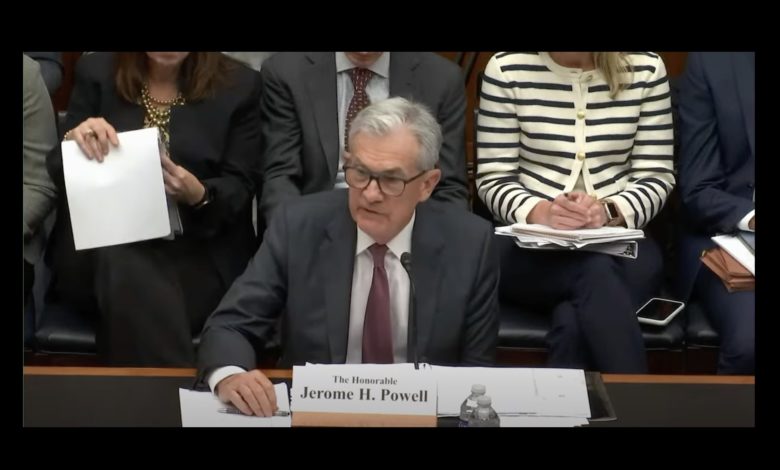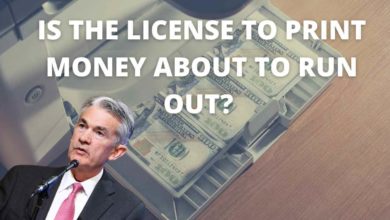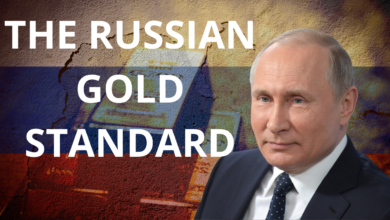Jerome Powell’s Open-Mouth Operations | SchiffGold

Federal Reserve Chairman Jerome Powell testified before the House Financial Services Committee on Wednesday (June 21). The Fed chief engaged in some more open-mouth operations, trying to guide monetary policy with words instead of actions.
To understand a few things he said, you have to read between the lines.
Oh, and he also got at least a couple of things wrong along the way.
Last week, the Federal Reserve skipped hiking rates, but ratcheted up the hawkish talk, insisting the inflation fight isn’t over.
During his testimony on Capitol Hill, Powell doubled down on the hawkishness, saying, “Inflation pressures continue to run high, and the process of getting inflation back down to 2% has a long way to go.”
He also insisted that the skipped rate was not a “pause.”
We never used the word ‘pause,’ and I wouldn’t use it here today.”
The Fed chair also offered a little analogy.
Now we’re moderating that pace, much as you might do if you were to be driving 75 miles an hour on a highway, then 50 miles an hour on a local highway, then as you get closer to your destination, you try to find that destination — you slow down even further.”
There is clearly a disconnect between what the Fed is doing and what Powell is saying. After all, if the Fed was really that hawkish, why skip a rate hike?
Mises Institute executive editor Ryan McMaken summed it up, saying Powell wants to have it both ways.
Powell wants to announce he and the FOMC are firmly committed to combating price inflation by allowing interest rates to rise—and, by the way, allowing more securities to roll off the Fed’s $8.3 trillion balance sheet. At the same time, Powell also wants to claim that now is a good time to pause on rate hikes, even though the Fed’s favored PCE measure of price inflation is more than double the Fed’s target rate of two percent.”
He went on to say the reason for this muddled messaging “is not completely mysterious.”
The answer lies in examining the political situation. Fantasies about “fed independence” might blind some observers to the reality, but the Fed is a profoundly political institution and must juggle a variety of political pressures. As it is, the Fed must seem like it is “doing something” about price inflation while simultaneously avoiding any moves that will cause the economy to slow to the point where it becomes politically problematic for the administration. The incoherence we now see from Powell is a direct result of the Fed’s desire to send several conflicting messages at once.”
READING BETWEEN THE LINES
Powell made a couple of comments that you need to read between the lines to fully appreciate.
The Fed chair said, “We want to get back to price stability, want to get back to that place where inflation is low enough that people don’t think about it.” [Emphasis added]
In other words, the central bank wants to keep devaluing the dollar, but not so fast that you feel the pain on a daily basis. The Fed prefers a “boil the frog slowly” approach so you don’t notice that it is taking away your purchasing power year after year. In other words, keep the inflation tax low enough so as not to upset the masses.
Consider this: at 2% inflation, you lose 10% of your purchasing power every five years.
And that’s the target.
Powell also said “Inflation has consistently surprised us, and essentially all other forecasters, by being more persistent than expected. And I think we’ve come to expect that — expect it to be more persistent.”
In other words, we’re not very good at our jobs.
Remember when Powell and Company were insisting that “inflation is transitory?”
It wasn’t until December 2021 that government officials finally conceded inflation wasn’t transitory. I was saying this at least six months earlier. You will note that I am not a Fed official. How was it that I wasn’t surprised but the “experts” who are running the economy were?
TWO THINGS POWELL GOT WRONG
Powell got at least two things wrong during his chat with the Financial Services Committee.
First, he claimed, “A very strong labor market is driving the economy.”
Wrong!
In the first place, a lot of the job data simply doesn’t add up.
And whatever real strength exists in the labor market is the result of a weak economy, high price inflation, and falling real wages that are driving people to take on extra work in order to make ends meet.
Price inflation is eating everybody’s lunch, and more and more people are taking on part-time work (part-time jobs count as jobs) with many even opting for a second full-time job. Meanwhile, retirees are being forced to return to the workforce because inflation is ravaging their fixed incomes.
This is not a sign of a “robust” economy. It’s a sign of economic desperation.
Second, Powell totally sidestepped the root cause of global price inflation, calling “the pandemic” the “common factor” driving prices higher.
Wrong!
The pandemic – or more accurately, the government response to the pandemic – was certainly part of the equation. But the real common factors were central bank policies of artificially low interest rates and quantitative easing, along with government deficit spending.
And this started long before the pandemic.
Central banks around the world pumped trillions of dollars of new money into the global economy in the wake of the 2008 financial crisis. The Federal Reserve held rates at zero for years and some central banks, including the European Central Bank and the Bank of Japan, introduced negative interest rate policies.
Of course, central banks doubled down on these easy money policies during the pandemic, pumping trillions of additional dollars into the economy. This is the root cause of price inflation, not COVID-19. By pinning price inflation on the “pandemic” in the abstract, Powell shifts blame away from the real culprit – the man looking back at him in the mirror every morning and his fellow central bankers.
Call 1-888-GOLD-160 and speak with a Precious Metals Specialist today!
Buka akaun dagangan patuh syariah anda di Weltrade.
Source link







